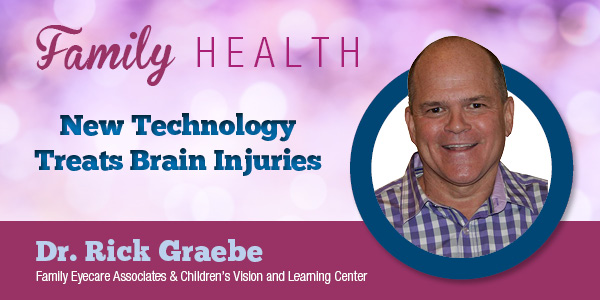New Technology Treats Brain Injuries
Ever the innovator and admirer of cutting edge technology, Dr. Rick Graebe wasted no time adding a new device to his practice’s toolbox – RightEye.
“The day the new portable model was available they shipped it to us,” said Graebe, a behavioral optometrist in Versailles.
The new model features special software that helps measure eye tracking, a crucial component of the visual system.
Students who struggle to read often have perfect 20-20 vision, but their ability to point and track their eyes along the page is underdeveloped. These students are ideal candidates for Vision Therapy, a kind of physical therapy for the eyes, brain and body and a specialty of Dr. Graebe’s practice.
The new RightEye technology generates vast amounts of data that show precise eye movement.
“This technology can confirm autism,” said Dr. Graebe, who added, “It can also confirm concussions.”
Dr. Graebe treats numerous patients who have suffered brain injuries either through strokes or accidents. He has treated enough teenage athletes with brain injuries that he sees this new technology as ideal for sports teams such as football, soccer, baseball, softball, lacrosse, ice hockey and other contact sports.
“RightEye is portable so we can take it out in the field,” Dr. Graebe. “We can get baseline numbers on a whole team so that if a player is injured we can diagnose the situation quickly and accurately.”
Treating the visual system after a head/brain injury is crucial because it is so often overlooked. With acquired brain injuries, vision is tabbed the hidden disability.
The issue stems from the sensitivity of the visual system, which consists of pathways that feed information that the eyes gather to the brain. And at least 70% of what the brain processes comes from the visual system.
“These pathways aren’t created at birth,” Dr. Graebe said. “Instead, the visual system is learned through feedback and interaction with the physical world. A brain injury can disrupt that learning, and we have to start all over again in building up the pathways.”
Often the symptoms manifest in the ambient part of the visual system that affects balance, timing, depth perception and spatial awareness. These are crucial for all of us but especially so with athletes.
“This is a phenomenal tool,” Dr. Graebe said. “What drives me daily is helping people reach their potential. I like athletes because they are competitors.
“They are striving to be best they can be, and we can help with that.”

